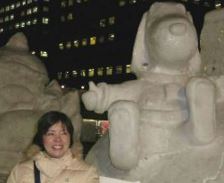
Wildlife in Hokkaido
The island of Hokkaido in the north of Japan is home to a variety of indigenous wildlife. There are unique species of bear, deer and fox as well as a number of plants that cannot be found anywhere else.
In this blog by Japanese teacher Sayuri Itaya, the teacher introduces a very cute animal that can be found in Hokkaido prefecture. Please read the blog in Japanese, study the Kanji and check the English translation too.
Itaya sensei reads out the blog in the YouTube video, so please watch, listen and practice Japanese for free.
北海道のめんこい「エゾモモンガ」
Ezo Momonga

By ITAYA Sayuri

皆さん、まずは この「めんこい」写真をご覧ください。(めんこいは北海道弁で、カワイイの意味です)木の穴からひょっこり顔を出している動物がいます。 こちらを見て微笑んでいるように見えますね。これは、ネズミでも、リスでも ありません。 「エゾモモンガ」という、北海道にだけ生息している 動物です。
 こちらの写真は穴から出ようとしているようです。 「どっこいしょ」という声が聞こえてきそうですね。
こちらの写真は穴から出ようとしているようです。 「どっこいしょ」という声が聞こえてきそうですね。

穴から出た姿がこちら。 丸くて大きな目が、本当にめんこいですね! 体長は15cm~18cm、体重は100g前後で、とても小さいです。

見る角度によって その目はハートの形にも見えます。そしてよく見ると、目の周りも黒くて、まるで女性がアイシャドーを使っているかのようです。
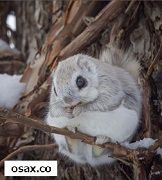
丸々と太って見えるモフモフの「モモちゃん」は 木の穴を巣にしているので地上にはほとんど降りません。爪が鋭いので、木登りが得意です。 そして、秘密があります。
なんと「モモちゃん」は、木から木へ 滑空して 飛び移ることができるのです。 前脚から 後脚にかけて 飛膜というものがあり、これを広げて 滑空します。
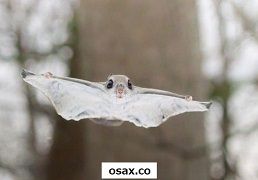
木々の間を通常20~30m滑空し、時には100m以上も移動することもあるとか。 「森の忍者」とも 呼ばれているそうです。下から見ると 空飛ぶ食パンに見えるかもしれません。
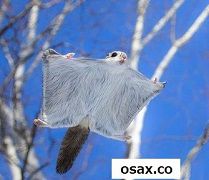
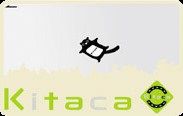
めんこい「モモちゃん」は JR北海道のICカード乗車券 Kitaca(キタカ)(東京のSuicaのようなもの)のキャラクターにも なっています。

こんな笑顔のめんこいモモちゃんに ぜひ会いたいものですが、なかなか難しそうです。私はSNSで見るだけですが、北海道内の動物園でも見られるそうです。
今回は写真家「まさ」さん(osax.co)に お願いし、たくさんの すばらしい写真を 使わせていただきました。ありがとうございました。
To listen to this blog, please watch our Youtube video.
北海道(ほっかいどう)のめんこい「エゾモモンガ」
皆(みな)さん、まずは この「めんこい」写真(しゃしん)を ご覧(らん)ください。 (「めんこい」は 北海道弁(ほっかいどうべん)で、カワイイの 意味です) 木(き)の 穴(あな)から ひょっこり 顔(かお)を 出(だ)している動物(どうぶつ)が います。 こちらを見(み)て 微笑(ほほえ)んでいるように 見えますね。 これは、ネズミでも、リスでも ありません。 「エゾモモンガ」という、北海道にだけ 生息(せいそく)している動物です。
こちらの写真は 穴から 出(で)ようとしているようです。 「どっこいしょ」という声(こえ)が 聞(き)こえてきそうですね。
穴から 出た姿(すがた)が こちら。 丸(まる)くて大(おお)きな目(め)が、本当(ほんとう)に めんこいいですね! 体長(たいちょう)は15cm~18cm、体重(たいじゅう)は100g前後(ぜんご)で、とても小さいです。
見る角度(かくど)によって その目はハートの形(かたち)にも 見えます。そしてよく見ると、目の周(まわ)りも 黒くて、まるで 女性(じょせい)が アイシャドーを 使(つか)っているかのようです。
丸々(まるまる)と 太(ふと)って 見える モフモフの「モモちゃん」は 木の穴を 巣(す)に しているので 地上(ちじょう)には ほとんど降(お)りません。爪(つめ)が 鋭(するど)いので、木登(きのぼ)りが得意(とくい)です。 そして、秘密(ひみつ)が あります。
なんと 「モモちゃん」は、木から 木へ 滑空(かっくう)して 飛(と)び移(うつ)ることができるのです。 前脚(まえあし)から 後脚(あとあし)にかけて 飛膜(ひまく)というものがあり、これを広(ひろ)げて 滑空します。
木々(きぎ)の間(あいだ)を 通常(つうじょう)20~30m滑空し、時(とき)には100m以上(いじょう)も 移動(いどう)することも あるとか。「森(もり)の忍者(にんじゃ)」とも 呼(よ)ばれているそうです。 下(した)から 見(み)ると 空(そら)飛(と)ぶ 食(しょく)パンに 見えるかもしれません。
めんこい「モモちゃん」は JR北海道のICカード乗車券(じょうしゃけん) Kitaca(キタカ)(東京(とうきょう)のSuicaと同(おな)じようなもの)の キャラクターにもなっています。
こんな笑顔(えがお)の めんこいモモちゃんに ぜひ会(あ)いたいものですが、なかなか 難(むずか)しそうです。 私はSNSで見るだけですが、北海道内(ない)の 動物園(どうぶつえん)でも 見られるそうです。
今回(こんかい)は 写真家(しゃしんか)「まさ」さん(osax.co)に お願(ねが)いし、たくさんの すばらしい写真(しゃしん)を 使(つか)わせていただきました。 ありがとうございました。
Hokkaido's Menkoi 'Ezo Momonga'.
First of all, please take a look at this 'Menkoi' photo. ('Menkoi' is a Hokkaido dialect word meaning 'kawaii' or cute). You can see an animal peeking out from a hole in a tree. It looks like it is looking and smiling pleasantly at us. This is not a mouse nor is it a squirrel. It is the 'Ezo Momonga', an animal that lives only in Hokkaido.
In this photo, it looks like it is trying to get out of its hole. You can almost hear it saying, "Dokkoi-sho!"
Here is a picture of it outside of its burrow. Its big, round eyes are really 'Menkoi'! They are very small, measuring 15-18 cm in length and weighing around 100 g.
These "Momo-chan" are fat, rotund and fluffy and they rarely go down to the ground and use tree holes as nests. They have sharp claws and are good tree climbers. And they have a secret.
The "Momo-chan" can glide and jump from tree to tree. They glide by spreading flying membranes from their front legs to their hind legs. They usually glide between trees for 20-30 metres, sometimes for more than 100 metres. They are also known as 'forest ninjas'.
Seen from below, they can look like flying loaves of bread. The "Momo-chan" is also the character for JR Hokkaido's Kitaca IC card (rather like a Suica card in Tokyo).
I would love to meet a "Momo-chan" with a smile like this, but it seems to be quite difficult. I only see her on SNS, but I hear that you can see them in zoos in Hokkaido.
The photographs used here are used with permission from the photographer, Masa (osax.co). Thank you very much, Masa.
北海道(ほっかいどう): Hokkaido (island, prefectural-level administrative unit)
北海道弁(ほっかいどうべん): Hokkaido dialect
穴(あな): hole
ひょっこり: all of a sudden; suddenly; by chance; unexpectedly
微笑む(ほほえむ): to smile
生息(せいそく): inhabiting; living
どっこいしょ: heigh-ho; heave-ho
姿(すがた): igure; form; shape; appearance
体長(たいちょう): length (of an animal)
体重(たいじゅう): (body) weight
角度(かくど): angle
アイシャドー: eyeshadow
丸々(まるまる): plump; rotund; chubby
モフモフ: soft to the touch (e.g. fur, feathers); fluffy
巣(す): nest
爪(つめ): claw; nail (e.g. fingernail, toenail)
鋭い(するどい): sharp; pointed
木登り(きのぼり): tree climbing
秘密(ひみつ): secret
滑空(かっくう): gliding (through the air)
飛び移る(とびうつる): to jump from one thing to another
前脚(まえあし): forefoot; forefeet; foreleg
後脚(あとあし): hind legs; rear legs
飛膜(ひまく): patagium (vertebrate flying or gliding membrane)
食(しょく)パン: white bread
忍者(にんじゃ):ninja; person trained in ninjutsu and employed for covert purposes in feudal Japan
JR北海道(ジェイアールほっかいどう):Hokkaido Railway Company
ICカード(アイシーカード): integrated circuit card; ICC
乗車券(じょうしゃけん): ticket (for bus, train, etc.); passenger ticket
Kitaca (キタカ, Kitaka) is a rechargeable contactless smart card ticketing system for public transport in Sapporo, Japan. Hokkaidō Railway Company (JR Hokkaidō) introduced the system from October 25 2008. Its name means "the card of north (北, kita)", while 北 is also the first character of Hokkaidō (北海道). (From Wikipedia)
Suica 【スイカ】 Suica; rechargeable prepaid IC card used for travel and purchases
笑顔(えがお): smiling face; smile
Hajimemashite, everyone. My name is Itaya Sayuri. I live in Sapporo, Hokkaido.
Sapporo is a really liveable city because, although we have a lot of snow in the winter, the summers are much cooler than other areas of Japan. Apart from teaching Japanese, I also hope to let everyone know about Sapporo, its beautiful nature and delicious food.
I play volleyball once or twice a week for my health and play golf on occasion. I also love watching movies.
Do you think the Japanese language is difficult? Well, come and enjoy studying with me in our online Japanese classroom?don't worry about making mistakes and just try to speak up as much as possible. I think this is the secret to success in Japanese. Ganbare!



